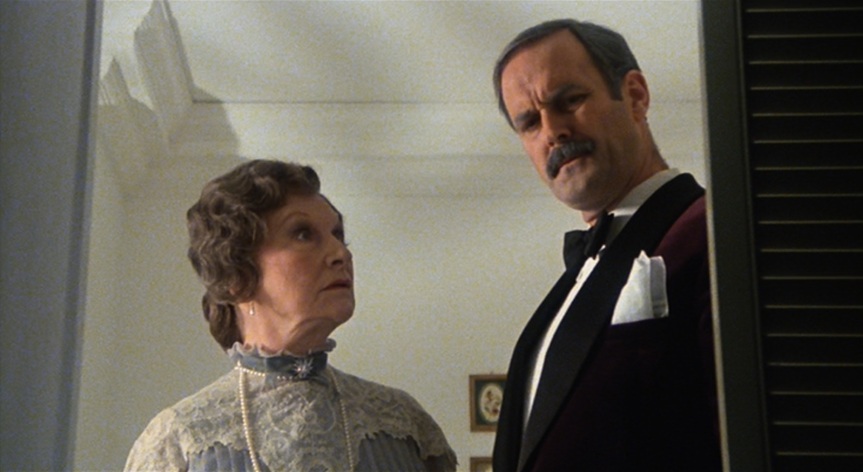
I do love it when our son enjoys a film more than I did. “That was comedy gold,” he exclaimed. I don’t love it when I enjoy a film a lot less than I once did. I honestly remembered 1981’s The Great Muppet Caper as being far more full of laughs than I found it this morning. There’s still a lot to like, but I was more amused by things that I probably wouldn’t have noticed when I last saw this, many years ago, like the costumes.
So for this outing, Kermit and Fozzie are investigative reporters who have followed the famous fashion designer Lady Holiday back to London to interview her about the theft of some of her jewels. Lady Holiday designs the ugliest things women have ever worn: bridesmaid dresses for ladies who hate their bridesmaids. It’s a beautifully unstated running gag, never acknowledged onscreen, while you just know Jim Henson had to keep sending back draft designs with kind notes that the ideas were simply not hideous enough. Lady Holiday’s brother, the irresponsible parasite Nicky, wears the worst men’s clothes in London. Even his socks are shocking.
I wondered how much of the script originally came from Henson, Oz, Rogers, and Goelz just sitting around with their characters improvising. There’s a hysterical moment where the Muppets break character and Kermit starts critiquing Miss Piggy’s performance. Piggy protests that she’s going for eighty emotions, and Kermit sighs that then surely she can get one of them right. The kid didn’t find this as funny as I did. Later on, Oscar the Grouch and Peter Ustinov bemoan their very brief cameos and I giggled for a full minute.

But the first of this movie’s two big problems is that the guest stars keep stealing the show from our heroes. I’m not sure it should be like this. Honestly, my favorite scene by a mile is when John Cleese and Joan Sanderson, who had played Cleese’s mostly deaf nemesis in a brilliantly funny Fawlty Towers a couple of years previously, have their dead pets and dismissed staff lifestyle intruded upon by a pig climbing the outside wall. Cleese begins hunting for the intruders with a fireplace poker and ends up recommending a supper club. But the problem from a Muppet perspective is that they aren’t amusing in response to anything the Muppets can do; their scene would have been every bit as hilarious if Tim Brooke-Taylor had played the wife and Marty Feldman had broken in.
This goes on all through the film. Diana Rigg and Charles Grodin, playing the Holidays, are far more interesting than Miss Piggy. Michael Robbins has a tiny scene as a museum guard who does not like pepperoni, and my eyes were on him, not Kermit and Fozzie. And then there’s Peter Falk, playing a tramp with a coat full of used wristwatches. Maybe he isn’t actually credited at the end because he felt bad for walking away with the movie entirely.
These probably don’t read like “problems,” but they are in a Muppet movie. The Muppets get in the way of the funniest stuff. In no universe should that ever be the case. Actually, the funniest Muppet moment is the first appearance of the running gag of everybody talking at once, and shushing at once, except for Janice, who’s in the middle of a mildly risque anecdote. Many of the later-day Muppet Show cast, including Pops and the Electric Mayhem’s trumpeter, Lips, are in this movie. Since it seems unlikely that seasons four and five of the Show will be seen again, at least in full, due to music rights issues, this is one of the few chances to see these characters right now.

That said, the other problem is that Paul Williams didn’t write the music. In The Muppet Movie, the songs are all great and they never overstayed their welcome. These songs aren’t and the film stops dead twice for very, very old-fashioned dance numbers. One’s all top hats and tails and the other is a water ballet with synchronized swimmers. The first could have been edited at least in half and the other should have been abandoned completely. Almost none of the other songs are in any way memorable; it’s been an hour and I’ve forgotten them already.
The exception is the Mayhem’s number, “Night Life.” This was actually a minor revelation to me, because I really just remember Lips’ trumpet being added to the TV show’s end credits music and didn’t remember what he added to the Mayhem’s sound. Granted, one part of my professed Electric Mayhem fandom is me being silly, and another part is just loving Floyd being such a smartass all the time, but Henson and company really did give the Mayhem some fine songs to play, and that trumpet in this song is awesome. I don’t know that Lips actually has much of a character, but he can play.
So it’s by no means a bad film, but I think it’s seriously flawed and about ten minutes too long. The kid loved it to pieces, because it’s full of slapstick and goofy lines and surprises and stunt drivers. At one point, Beauregard drives a cab right into the Happiness Hotel’s lobby, and I thought this might be our son’s favorite moment because he was laughing so hard that he was clutching his sides, and then, when he should have reversed out, he doesn’t. So it’s a great film for nine year-olds, and a pretty good one for their nitpicky parents.

















